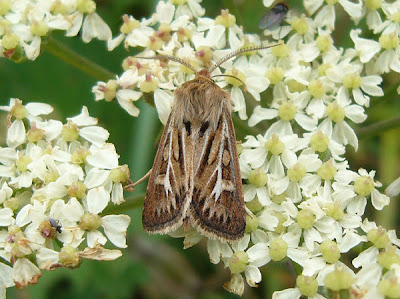It’s rare for Mull Magic to tramp the same area on consecutive outings, let alone re-visit it three days on the trot. Yet, that was the situation we found ourselves in this past week and three very different days we experienced, largely thanks to the vagaries of the Isle of Mull’s Summer climate. The weather may not have quite been of the ‘Four Seasons in One Day’ variety, but the elements certainly combined to throw Spring, Summer and Autumn at us on our recent ventures into the countryside. It did not darken or sully our mood, however, and provided us with some memorable wildlife experiences, as well as being a test of the ability of our waterproofs to stand up to all that Mull’s weather could throw at us!

Built within a sheltered and fertile hollow, the ruined settlement at Baliacrach offered us an insight in to the area’s less auspicious past. The remains of the village command fantastic views across the Sound of Mull to Ardnamurchan and to the islands of Muck and Rum beyond. However, the peace and tranquillity of today’s landscape serves only to mask the anguish, fear and despair of the tenants who once lived there and were brutally evicted at the time of the infamous Highland Clearances.

Dotted throughout on our grassy walks, we encountered the nodding lilac-blue flowerheads of our ‘Scottish Bluebell’. The Harebell is a delicate plant, whose flowers hang on the flimsiest of stems, belying an inner strength that allows it to withstand the worst of Mull’s weather at the height of Summer. The Harebell is known to produce a seed bank, which it keeps topped up year upon year. This ensures that, in difficult times and given the appropriate signal, there are always seeds capable of germinating and replenishing the adult population.

With its fluttering flight and metallic sheen, it is not difficult to imagining the Beautiful Demoiselle being mistaken as a butterfly. This exotic-looking damselfly has a rather disjunct British population and exists in scattered locations on the Isle of Mull, thanks to the mild influence of the Gulf Stream. We were treated to quite marvellous views of this male, bejewelled in its tropical violet-blue-green finery on a day when the sun blessed us with an appearance.

As we climbed to the top of an ancient castle overlooking the Sound of Mull, we spotted an aptly named Antler Moth getting drunk on the nectar of a Hogweed. It allowed such a close approach that we were able to easily make out the white, antler-like branches that give this familiar Summertime moth its common name.

Wet weather and warm temperatures have prompted a spate of early toadstools to emerge. ‘The Blusher’ is one of twenty-four species in the genus Amanita that can be found in Britain, which includes the widely recognised Fly Agaric. ‘The Blusher’ is common in both deciduous and coniferous woodland on the island and is edible after cooking. It does, however, resemble other more poisonous species that could kill with one taste!

 Built within a sheltered and fertile hollow, the ruined settlement at Baliacrach offered us an insight in to the area’s less auspicious past. The remains of the village command fantastic views across the Sound of Mull to Ardnamurchan and to the islands of Muck and Rum beyond. However, the peace and tranquillity of today’s landscape serves only to mask the anguish, fear and despair of the tenants who once lived there and were brutally evicted at the time of the infamous Highland Clearances.
Built within a sheltered and fertile hollow, the ruined settlement at Baliacrach offered us an insight in to the area’s less auspicious past. The remains of the village command fantastic views across the Sound of Mull to Ardnamurchan and to the islands of Muck and Rum beyond. However, the peace and tranquillity of today’s landscape serves only to mask the anguish, fear and despair of the tenants who once lived there and were brutally evicted at the time of the infamous Highland Clearances. Dotted throughout on our grassy walks, we encountered the nodding lilac-blue flowerheads of our ‘Scottish Bluebell’. The Harebell is a delicate plant, whose flowers hang on the flimsiest of stems, belying an inner strength that allows it to withstand the worst of Mull’s weather at the height of Summer. The Harebell is known to produce a seed bank, which it keeps topped up year upon year. This ensures that, in difficult times and given the appropriate signal, there are always seeds capable of germinating and replenishing the adult population.
Dotted throughout on our grassy walks, we encountered the nodding lilac-blue flowerheads of our ‘Scottish Bluebell’. The Harebell is a delicate plant, whose flowers hang on the flimsiest of stems, belying an inner strength that allows it to withstand the worst of Mull’s weather at the height of Summer. The Harebell is known to produce a seed bank, which it keeps topped up year upon year. This ensures that, in difficult times and given the appropriate signal, there are always seeds capable of germinating and replenishing the adult population. With its fluttering flight and metallic sheen, it is not difficult to imagining the Beautiful Demoiselle being mistaken as a butterfly. This exotic-looking damselfly has a rather disjunct British population and exists in scattered locations on the Isle of Mull, thanks to the mild influence of the Gulf Stream. We were treated to quite marvellous views of this male, bejewelled in its tropical violet-blue-green finery on a day when the sun blessed us with an appearance.
With its fluttering flight and metallic sheen, it is not difficult to imagining the Beautiful Demoiselle being mistaken as a butterfly. This exotic-looking damselfly has a rather disjunct British population and exists in scattered locations on the Isle of Mull, thanks to the mild influence of the Gulf Stream. We were treated to quite marvellous views of this male, bejewelled in its tropical violet-blue-green finery on a day when the sun blessed us with an appearance. As we climbed to the top of an ancient castle overlooking the Sound of Mull, we spotted an aptly named Antler Moth getting drunk on the nectar of a Hogweed. It allowed such a close approach that we were able to easily make out the white, antler-like branches that give this familiar Summertime moth its common name.
As we climbed to the top of an ancient castle overlooking the Sound of Mull, we spotted an aptly named Antler Moth getting drunk on the nectar of a Hogweed. It allowed such a close approach that we were able to easily make out the white, antler-like branches that give this familiar Summertime moth its common name. Wet weather and warm temperatures have prompted a spate of early toadstools to emerge. ‘The Blusher’ is one of twenty-four species in the genus Amanita that can be found in Britain, which includes the widely recognised Fly Agaric. ‘The Blusher’ is common in both deciduous and coniferous woodland on the island and is edible after cooking. It does, however, resemble other more poisonous species that could kill with one taste!
Wet weather and warm temperatures have prompted a spate of early toadstools to emerge. ‘The Blusher’ is one of twenty-four species in the genus Amanita that can be found in Britain, which includes the widely recognised Fly Agaric. ‘The Blusher’ is common in both deciduous and coniferous woodland on the island and is edible after cooking. It does, however, resemble other more poisonous species that could kill with one taste!



No comments:
Post a Comment